马尔文激光粒度仪简介
- 格式:doc
- 大小:787.00 KB
- 文档页数:47
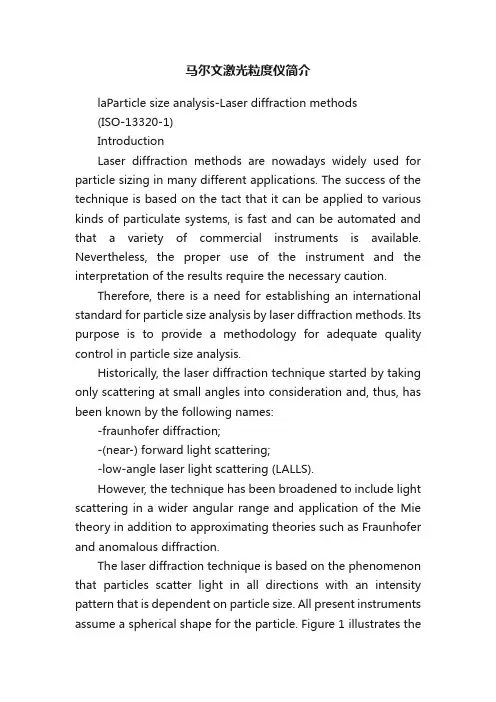
马尔文激光粒度仪简介laParticle size analysis-Laser diffraction methods(ISO-13320-1)IntroductionLaser diffraction methods are nowadays widely used for particle sizing in many different applications. The success of the technique is based on the tact that it can be applied to various kinds of particulate systems, is fast and can be automated and that a variety of commercial instruments is available. Nevertheless, the proper use of the instrument and the interpretation of the results require the necessary caution.Therefore, there is a need for establishing an international standard for particle size analysis by laser diffraction methods. Its purpose is to provide a methodology for adequate quality control in particle size analysis.Historically, the laser diffraction technique started by taking only scattering at small angles into consideration and, thus, has been known by the following names:-fraunhofer diffraction;-(near-) forward light scattering;-low-angle laser light scattering (LALLS).However, the technique has been broadened to include light scattering in a wider angular range and application of the Mie theory in addition to approximating theories such as Fraunhofer and anomalous diffraction.The laser diffraction technique is based on the phenomenon that particles scatter light in all directions with an intensity pattern that is dependent on particle size. All present instruments assume a spherical shape for the particle. Figure 1 illustrates thecharacteristics of single particle scattering patterns: alternation of high and low intensities, with patterns that extend for smaller particles to wider angles than for larger particles[2-7,10,15 in the bibliography].Within certain limits the scattering pattern of an ensemble of particles is identical to the sum of the individual scattering patterns of all particles present. By using an optical model to compute scattering for unit volumes of particles in selected size classes and a mathematical deconvolution procedure, a volumetric particle size distribution is calculated, the scattering pattern of which fits best with the measured pattern (see also annex A).A typical diffraction instrument consists of a light beam (usually a laser), a particulate dispersing device, a detector for measuring the scattering pattern and a computer for both control of the instrumentand calculation of the particle size distribution. Note that the laser diffraction technique cannot distinguish between scattering by single particles and scattering by clusters of primary particles forming an agglomerate or an aggregate. Usually, the resulting particle size for agglomerates is related to the cluster size, but sometimes the size of the primary particles is reflected in the particle size distribution as well. As most particulate samples contain agglomerates or aggregates and one is generally interested in the size distribution of the primary particles, the clusters are usually dispersed into primary particles before measurement.Historically, instruments only used scattering angles smaller than 14°,which limited the application to a lower size of about 1μm. The reason for this limitation is that smaller particles showmost of their distinctive scattering at larger angles (see also annex Z).Many recent instruments allow measurement at larger scattering angles, some up to about 150°,for example through application of a converging beam, more or larger lenses, a second laser beam or more detectors. Thus smaller particles dow n to about μm can be sized. Some instruments incorporate additional information from scattering intensities and intensity differences at various wavelengths and polarization planes in order to improve the characterization of particle sizes in the submicrometre range.Particle size analysis – Laser diffraction methods-Part 1:General principles1 scopeThis part of ISO 13320 provides guidance on the measurement of size distributions of particles in any two-phase system, for example powders, sprays, aerosols, suspensions, emulsions and gas bubbles in liquids, through analysis of their angular light scattering patterns. It does not address the specific requirements of particle size measurement of specific products. This part of ISO13320 is applicable to particle sizes ranging from approximately μm to 3μm.For non-spherical particles, an equivalent-sphere size distribution is obtained because the technique uses the assumption of spherical particles in its optical model. The resulting particle size distribution may be different from those obtained by methods based on other physical principles . Sedimentation, sieving).3,terms, definitions and symbolsFor the purposes of this part of ISO 13320, the followingterms, definitions and symbols apply.terms, definitionsabsorptionintroduction of intensity of a light beam traversing a medium through energy conversion in the mediumcoefficient of variation (变异系数)Noative measure(%) for precision: standard deviation divided by mean value of population and multiplied by 100 or normal distributions of data the median is equal to the mean refractive index(Np)Refractive index of a particle, consisting of a real and an imaginary (absorption) part.Np=n p-ik prelative refractive index (m)complex refractive index of a particle, relative to that the medium。
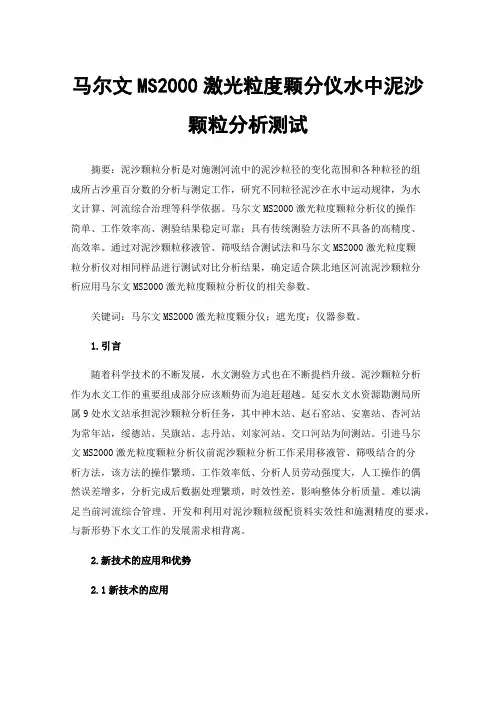
马尔文MS2000激光粒度颗分仪水中泥沙颗粒分析测试摘要:泥沙颗粒分析是对施测河流中的泥沙粒径的变化范围和各种粒径的组成所占沙重百分数的分析与测定工作,研究不同粒径泥沙在水中运动规律,为水文计算、河流综合治理等科学依据。
马尔文MS2000激光粒度颗粒分析仪的操作简单、工作效率高、测验结果稳定可靠;具有传统测验方法所不具备的高精度、高效率。
通过对泥沙颗粒移液管、筛吸结合测试法和马尔文MS2000激光粒度颗粒分析仪对相同样品进行测试对比分析结果,确定适合陕北地区河流泥沙颗粒分析应用马尔文MS2000激光粒度颗粒分析仪的相关参数。
关键词:马尔文MS2000激光粒度颗分仪;遮光度;仪器参数。
1.引言随着科学技术的不断发展,水文测验方式也在不断提档升级。
泥沙颗粒分析作为水文工作的重要组成部分应该顺势而为追赶超越。
延安水文水资源勘测局所属9处水文站承担泥沙颗粒分析任务,其中神木站、赵石窑站、安塞站、杏河站为常年站,绥德站、吴旗站、志丹站、刘家河站、交口河站为间测站。
引进马尔文MS2000激光粒度颗粒分析仪前泥沙颗粒分析工作采用移液管、筛吸结合的分析方法,该方法的操作繁琐、工作效率低、分析人员劳动强度大,人工操作的偶然误差增多,分析完成后数据处理繁琐,时效性差,影响整体分析质量。
难以满足当前河流综合管理、开发和利用对泥沙颗粒级配资料实效性和施测精度的要求,与新形势下水文工作的发展需求相背离。
2.新技术的应用和优势2.1新技术的应用黄河流域黄河水利委员会所属三门峡、吕梁、榆次水文局,陕西省水文水资源勘测局所属宝鸡局先后开始在黄河流域范围内使用马尔文MS2000激光粒度颗粒分析仪开展泥沙颗粒分析工作。
通过这些年来的应用不断总结经验,改进提升,马尔文MS2000激光粒度颗粒分析仪能够满足水文测验要求。
延安水文水资源勘测局管辖流域同属黄河流域中游区域,为顺应水文测验技术的发展需要,提升工作效率,提高测验质量,延安水文水资源勘测局开展马尔文MS2000激光粒度颗粒分析仪进行泥沙颗粒分析与传统测验方式的比对,验证相关参数在实际工作中的可靠性和合理性,为今后开展新技术的应用打下坚实的基础。
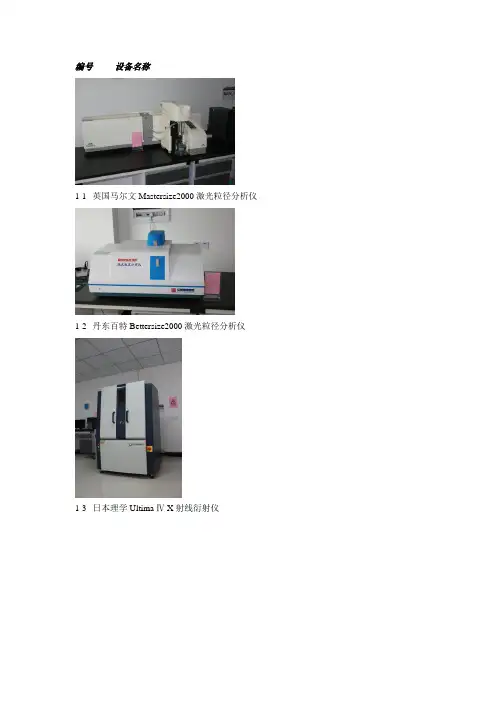
编号设备名称
1-1英国马尔文Mastersize2000激光粒径分析仪
1-2丹东百特Bettersize2000激光粒径分析仪
1-3日本理学Ultima Ⅳ X射线衍射仪
1-4德国布鲁克S8 TIGER波长色散型X射线荧光光谱仪
1-5 综合检验室
2-1 国产DXR显气孔率、体积密度测定仪
2-2 美国康塔NOV A3000e比表面积及孔隙度测定仪
2-3 丹东百特BT-1600图像颗粒分析系统
2-4 丹东百特BT-1000粉体综合测试仪
2-5 白度测定仪
2-6 粉体综合特性分析设备
3-1 珀金埃尔默Optima 7300DV电感耦合等离子体发射光谱仪
3-2 德国耶拿ZEEnit 700P火焰石墨炉原子吸收光谱仪
3-3 北京吉天AFS-930D原子荧光光度计
3-4 美国热电IS10傅立叶变换红外光谱仪
3-5 法国塞塔拉姆S60同步热分析仪
3-6 美国奥林巴斯BX51偏光显微镜
4-1 德国布鲁克G4 Icarus HF红外碳硫分析仪
4-2 美特斯SHT4106微机控制电液伺服万能试验机
4-3 国产CHY材料荷重软化温度测定仪
4-4 国产DRH-300导热系数测试仪(双护热平板法)
4-5 国产DRS-Ⅲ导热系数测试仪(水流量平板法)
中心内景
中心外景。
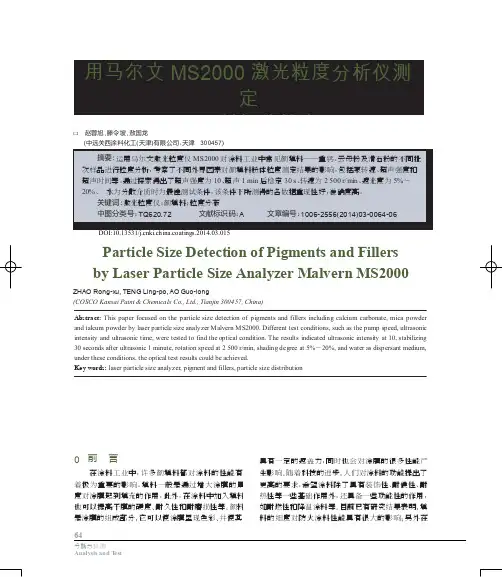
□ 赵蓉旭,滕令坡,敖国龙中远关西涂料化工天津有限公司,天津 Particle Size Detection of Pigments and Fillersby Laser Particle Size Analyzer Malvern MS2000ZHAO Rong-xu, TENG Ling-po, AO Guo-long(COSCO Kansai Paint & Chemicals Co., Ltd., Tianjin 300457, China)Abstract: This paper focused on the particle size detection of pigments and fillers including calcium carbonate, mica powder and talcum powder by laser particle size analyzer Malvern MS2000. Different test conditions, such as the pump speed, ultrasonic intensity and ultrasonic time, were tested to find the optical condition. The results indicated ultrasonic intensity at 10, stabilizing 30 seconds after ultrasonic 1 minute, rotation speed at 2 500 r/min, shading degree at 5%~20%, and water as dispersant medium, under these conditions, the optical test results could be achieved.Key words: laser particle size analyzer, pigment and fillers, particle size distribution前 言0 具有一定的遮盖力,同时也会对涂膜的很多性能产 生影响。

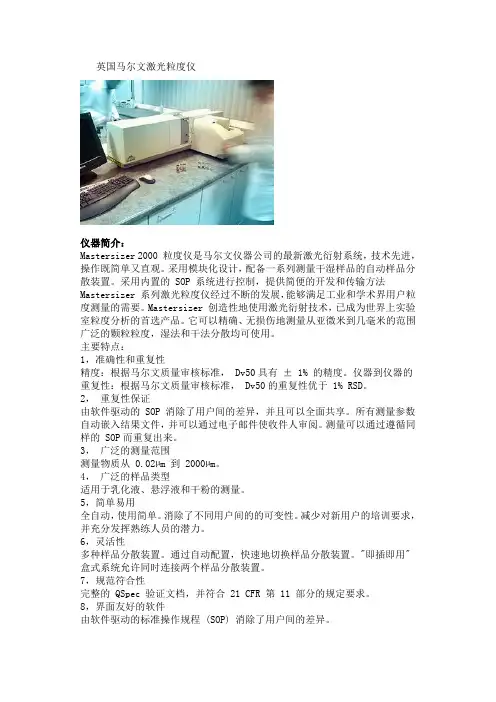
英国马尔文激光粒度仪仪器简介:Mastersizer 2000 粒度仪是马尔文仪器公司的最新激光衍射系统,技术先进,操作既简单又直观。
采用模块化设计,配备一系列测量干湿样品的自动样品分散装置。
采用内置的 SOP 系统进行控制,提供简便的开发和传输方法Mastersizer 系列激光粒度仪经过不断的发展,能够满足工业和学术界用户粒度测量的需要。
Mastersizer 创造性地使用激光衍射技术,已成为世界上实验室粒度分析的首选产品。
它可以精确、无损伤地测量从亚微米到几毫米的范围广泛的颗粒粒度,湿法和干法分散均可使用。
主要特点:1,准确性和重复性精度:根据马尔文质量审核标准, Dv50具有± 1% 的精度。
仪器到仪器的重复性:根据马尔文质量审核标准, Dv50的重复性优于 1% RSD。
2,重复性保证由软件驱动的 SOP 消除了用户间的差异,并且可以全面共享。
所有测量参数自动嵌入结果文件,并可以通过电子邮件使收件人审阅。
测量可以通过遵循同样的 SOP而重复出来。
3,广泛的测量范围测量物质从0.02µm 到2000µm。
4,广泛的样品类型适用于乳化液、悬浮液和干粉的测量。
5,简单易用全自动,使用简单。
消除了不同用户间的的可变性。
减少对新用户的培训要求,并充分发挥熟练人员的潜力。
6,灵活性多种样品分散装置。
通过自动配置,快速地切换样品分散装置。
"即插即用"盒式系统允许同时连接两个样品分散装置。
7,规范符合性完整的 QSpec 验证文档,并符合 21 CFR 第 11 部分的规定要求。
8,界面友好的软件由软件驱动的标准操作规程 (SOP) 消除了用户间的差异。
SOP 创建向导帮助用户创建最佳的测量方法。
只需单击按钮便可获取执行测量的各个方面的在线帮助和建议。
屏幕说明引导用户完成测量过程。
SOP 可用于例行样品分析。
自定义报告设计程序允许每个用户根据需要配置屏幕布置和打印输出。
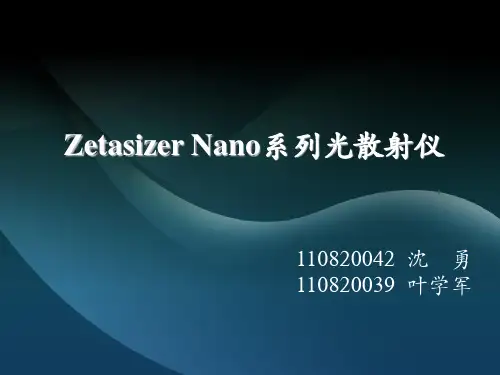
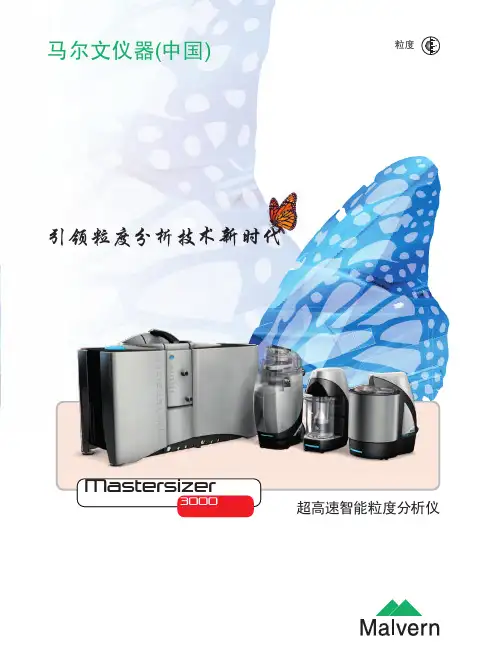
超高速智能粒度分析仪粒度引领粒度分析技术新时代Mastersizer3000马尔文仪器(中国)Mastersizer 3000不仅仅是一台新仪器—它是全新的粒度测量大师马尔文仪器公司于1970年推出世界第一台商用激光粒度仪。
随后第一套Mastersizer 系统在1988年诞生,自此,马尔文仪器一直引领着激光衍射粒度分析领域的发展。
我们投身于这一技术,并为世界各地超过10,000家的Mastersizer 用户带来最新的技术、应用和各种粒度分析解决方案。
The Mastersizer3000最高性能、最小体积Mastersizer 3000—最先进的系统快速、可靠且高度自动化的激光衍射技术已经成为了世界上使用最广泛的粒度分析技术。
现在,Mastersizer 3000将引领激光衍射技术步入全新的高速智能时代。
23Mastersizer 3000的优势Mastersizer 3000仪器及其分散系统的创新设计和革新工艺体现了马尔文公司的热诚和专业。
我们根据市场需求开发了在最小的空间中包含最全面性能的仪器。
快速而准确,Mastersizer 3000让所有人都能得心应手,无论是新用户还是粒度分析专家。
The Mastersizer 3000革新的光学核心Mastersizer 3000利用经过验证的激光衍射技术测定颗粒粒径。
根据测定样品产生的在不同角度上的衍射光强度分布来计算粒度分布。
采集这些数据所需的光学系统是本仪器的核心。
在新型的折叠光路设计中,Mastersizer 3000中的蓝光固态光源保证了亚微米级的分辨率,使粒径分析下限达到10nm。
高速的数据采集速率大大增加了测试中的信号采集次数,提高了分析的重现性,即使是分布最宽的样品也能精确测定。
同时也显著提高了测试速度。
总之,依靠该独特的光学系统,仅一台仪器即可在整个极宽的动态范围内获得值得信赖的粒径数据。
The Mastersizer30002466734强大而便捷的软件—使您的分析工作更加高效,并轻松获得可靠结果The Mastersizer 3000轻轻一点,即可全面控制所有的分散参数:在您方法开发的过程中进行实时控制滚动趋势图和数据统计:符合ISO13320指导方针的快速方法优化3.优化查看测量参数和粒度分布:即时反馈结果5激光衍射测量不再是专家才能完成的任务——这也是该技术的一项诉求。
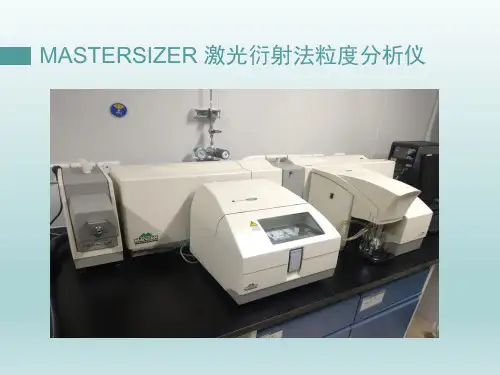
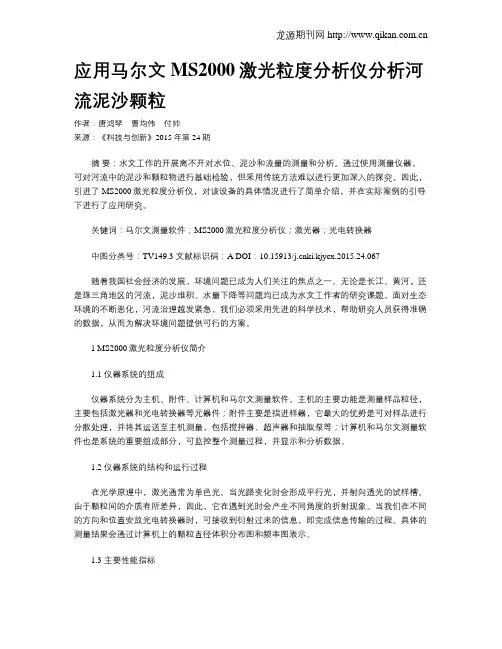
应用马尔文MS2000激光粒度分析仪分析河流泥沙颗粒作者:唐鸿琴曹均伟付帅来源:《科技与创新》2015年第24期摘要:水文工作的开展离不开对水位、泥沙和流量的测量和分析。
通过使用测量仪器,可对河流中的泥沙和颗粒物进行基础检验,但采用传统方法难以进行更加深入的探究。
因此,引进了MS2000激光粒度分析仪,对该设备的具体情况进行了简单介绍,并在实际案例的引导下进行了应用研究。
关键词:马尔文测量软件;MS2000激光粒度分析仪;激光器;光电转换器中图分类号:TV149.3 文献标识码:A DOI:10.15913/ki.kjycx.2015.24.067随着我国社会经济的发展,环境问题已成为人们关注的焦点之一。
无论是长江、黄河,还是珠三角地区的河流,泥沙堆积、水量下降等问题均已成为水文工作者的研究课题。
面对生态环境的不断恶化,河流治理越发紧急,我们必须采用先进的科学技术,帮助研究人员获得准确的数据,从而为解决环境问题提供可行的方案。
1 MS2000激光粒度分析仪简介1.1 仪器系统的组成仪器系统分为主机、附件、计算机和马尔文测量软件。
主机的主要功能是测量样品粒径,主要包括激光器和光电转换器等元器件;附件主要是指进样器,它最大的优势是可对样品进行分散处理,并将其运送至主机测量,包括搅拌器、超声器和抽取泵等;计算机和马尔文测量软件也是系统的重要组成部分,可监控整个测量过程,并显示和分析数据。
1.2 仪器系统的结构和运行过程在光学原理中,激光通常为单色光。
当光路变化时会形成平行光,并射向透光的试样槽。
由于颗粒间的介质有所差异,因此,它在遇到光时会产生不同角度的折射现象。
当我们在不同的方向和位置安放光电转换器时,可接收到衍射过来的信息,即完成信息传输的过程。
具体的测量结果会通过计算机上的颗粒直径体积分布图和频率图表示。
1.3 主要性能指标MS2000激光粒度分析仪具有较高的灵敏度,其测量速度和扫描速度较快。
因此,无论分析哪种颗粒,都可以在较短的时间内进行光路校正,从而完成数据的取样工作。
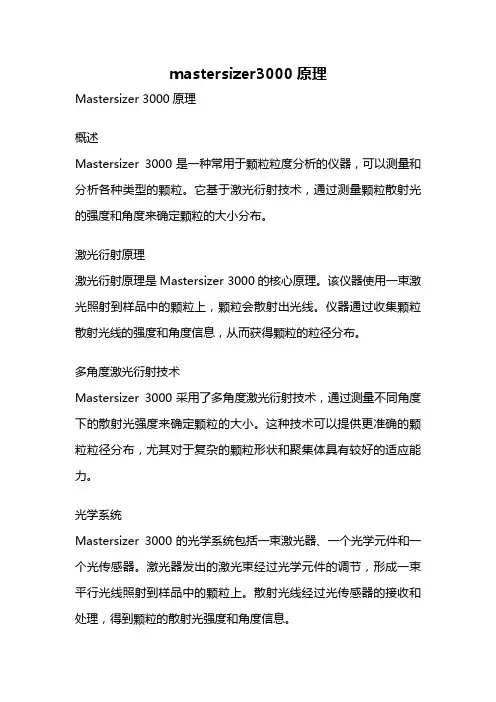
mastersizer3000原理Mastersizer 3000原理概述Mastersizer 3000是一种常用于颗粒粒度分析的仪器,可以测量和分析各种类型的颗粒。
它基于激光衍射技术,通过测量颗粒散射光的强度和角度来确定颗粒的大小分布。
激光衍射原理激光衍射原理是Mastersizer 3000的核心原理。
该仪器使用一束激光照射到样品中的颗粒上,颗粒会散射出光线。
仪器通过收集颗粒散射光线的强度和角度信息,从而获得颗粒的粒径分布。
多角度激光衍射技术Mastersizer 3000采用了多角度激光衍射技术,通过测量不同角度下的散射光强度来确定颗粒的大小。
这种技术可以提供更准确的颗粒粒径分布,尤其对于复杂的颗粒形状和聚集体具有较好的适应能力。
光学系统Mastersizer 3000的光学系统包括一束激光器、一个光学元件和一个光传感器。
激光器发出的激光束经过光学元件的调节,形成一束平行光线照射到样品中的颗粒上。
散射光线经过光传感器的接收和处理,得到颗粒的散射光强度和角度信息。
样品处理在进行粒度分析之前,需要对样品进行适当的处理。
对于液态样品,通常需要进行稀释以保证测量精度。
对于固态样品,需要进行适当的分散处理,以保证颗粒之间的分散均匀。
数据分析与结果展示Mastersizer 3000将测量得到的散射光强度和角度数据通过复杂的算法进行处理,得到颗粒的粒径分布。
分析结果通常以粒径分布曲线和统计参数的形式展示出来。
其中,粒径分布曲线反映了颗粒粒径的分布范围和峰值位置,而统计参数则提供了更具体的颗粒粒径信息。
仪器优势与应用领域Mastersizer 3000具有高精度、高灵敏度和宽测量范围等优点,广泛应用于各个领域的颗粒粒度分析。
例如,在制药工业中,可以用于药物微粒的质量控制和药效的研究;在化工领域,可以用于催化剂的制备和性能评估;在环境监测中,可以用于大气颗粒物和水中颗粒物的分析等。
总结Mastersizer 3000基于激光衍射原理,通过测量颗粒散射光的强度和角度来确定颗粒的大小分布。
马尔文激光粒度仪遮光率马尔文激光粒度仪遮光率马尔文激光粒度仪是一种被广泛应用于颗粒物测量的仪器设备。
它通过使用激光光源和光散射技术,可以快速、准确地测量颗粒物的大小与分布。
而在马尔文激光粒度仪中,遮光率是一个重要的指标,它可以反映出颗粒物测量过程中的粒体遮光程度。
在马尔文激光粒度仪中,遮光率是指颗粒物对激光光源的遮挡程度。
当颗粒物通过激光束时,它们会散射出光线,并遮挡住一部分光源。
遮光率的大小与颗粒物的浓度及大小有关,通常情况下,颗粒物浓度越高,遮光率就越大。
遮光率是马尔文激光粒度仪中一个重要的参数,它可以用来评估颗粒物的分布情况。
通过测量颗粒物对激光光源的遮挡程度,可以得到颗粒物的体积分布、大小分布等信息。
这些信息对于很多领域的研究和应用具有重要意义。
在环境领域,通过测量颗粒物的遮光率可以判断空气质量;在生物医学领域,通过测量颗粒物的遮光率可以评估药物输送系统的效果等。
马尔文激光粒度仪遮光率的测量原理是基于光散射理论的。
根据散射理论,当光通过颗粒物时,会发生散射现象,散射的程度与颗粒物的大小成正比。
通过测量散射光的强度,就可以间接地推导出颗粒物的大小。
在马尔文激光粒度仪中,光散射强度与遮光率有关,通过测量散射光的强度,可以计算出颗粒物的遮光率。
在实际应用中,为了准确测量遮光率,需要注意一些因素的影响。
颗粒物的颜色、浓度和形状等都会对遮光率的测量结果产生影响。
仪器的参数设置和使用方法也会对测量结果产生影响。
在进行遮光率的测量时,需要对这些因素进行控制,并进行合理的校正,以确保测量结果的准确性和可靠性。
总结回顾:马尔文激光粒度仪遮光率是评估颗粒物测量过程中粒体遮光程度的重要指标。
通过测量颗粒物对激光光源的遮挡程度,可以得到颗粒物的体积分布、大小分布等信息,对于环境、生物医学等领域的研究和应用具有重要意义。
在测量过程中需要注意颗粒物的颜色、浓度和形状等因素的影响,并进行合理的校正,以确保测量结果的准确性和可靠性。
马尔文激光粒度仪简介laParticle size analysis-Laser diffraction methods(ISO-13320-1)IntroductionLaser diffraction methods are nowadays widely used for particle sizing in many different applications. The success of the technique is based on the tact that it can be applied to various kinds of particulate systems, is fast and can be automated and that a variety of commercial instruments is available. Nevertheless, the proper use of the instrument and the interpretation of the results require the necessary caution.Therefore, there is a need for establishing an international standard for particle size analysis by laser diffraction methods. Its purpose is to provide a methodology for adequate quality control in particle size analysis.Historically, the laser diffraction technique started by taking only scattering at small angles into consideration and, thus, has been known by the following names:-fraunhofer diffraction;-(near-) forward light scattering;-low-angle laser light scattering (LALLS).However, the technique has been broadened to include light scattering in a wider angular range and application of the Mie theory in addition to approximating theories such as Fraunhofer and anomalous diffraction.The laser diffraction technique is based on the phenomenon that particles scatter light in all directions with an intensity pattern that is dependent on particle size. All present instruments assume a spherical shape for the particle. Figure 1 illustrates the characteristics of single particle scattering patterns: alternation of high and low intensities, with patterns that extend for smaller particles to wider angles than for larger particles[2-7,10,15 in the bibliography].Within certain limits the scattering pattern of an ensemble of particles is identical to the sum of the individual scattering patterns of all particles present. By using an optical model to compute scattering for unit volumes of particles in selected size classes and a mathematical deconvolution procedure, a volumetric particle size distribution is calculated, the scattering pattern of which fits best with the measured pattern (see also annex A).A typical diffraction instrument consists of a light beam (usually a laser), a particulate dispersing device, a detector for measuring the scattering pattern and a computer for both control of the instrument and calculation of the particle size distribution. Note that the laser diffraction technique cannot distinguish between scattering by single particles andscattering by clusters of primary particles forming an agglomerate or an aggregate. Usually, the resulting particle size for agglomerates is related to the cluster size, but sometimes the size of the primary particles is reflected in the particle size distribution as well. As most particulate samples contain agglomerates or aggregates and one is generally interested in the size distribution of the primary particles, the clusters are usually dispersed into primary particles before measurement.Historically, instruments only used scattering angles smaller than 14°,which limited the application to a lower size of about 1μm. The reason for this limitation is that smaller particles show most of their distinctive scattering at larger angles (see also annex Z).Many recent instruments allow measurement at larger scattering angles, some up to about 150°,for example through application of a converging beam, more or larger lenses, a second laser beam or more detectors. Thus smaller particles down to about 0.1μm can be sized. Some instruments incorporate additional information from scattering intensities and intensity differences at various wavelengths and polarization planes in order to improve the characterization of particle sizes in the submicrometre range.Particle size analysis – Laser diffraction methods-Part 1:General principles1 scopeThis part of ISO 13320 provides guidance on the measurement of size distributions of particles in any two-phase system, for example powders, sprays, aerosols, suspensions, emulsions and gas bubbles in liquids, through analysis of their angular light scattering patterns. It does not address the specific requirements of particle size measurement of specific products. This part of ISO13320 is applicable to particle sizes ranging from approximately 0.1μm to 3μm.For non-spherical particles, an equivalent-sphere size distribution is obtained because the technique uses the assumption of spherical particles in its optical model. The resulting particle size distribution may be different from those obtained by methods based on other physical principles (e.g. Sedimentation, sieving).3,terms, definitions and symbolsFor the purposes of this part of ISO 13320, the following terms, definitions and symbols apply.3.1 terms, definitions3.1.1 absorptionintroduction of intensity of a light beam traversing a medium through energy conversion in the medium3.1.2 coefficient of variation (变异系数)Noative measure(%) for precision: standard deviation divided by mean value of population and multiplied by 100 or normal distributions of data the median is equal to the mean3.1.3complex refractive index(Np)Refractive index of a particle, consisting of a real and an imaginary (absorption) part.Np=n p-ik p3.1.4 relative refractive index (m)complex refractive index of a particle, relative to that the medium。
融合多项专利技术 挑战颗粒表征极限持续革新与优化 再创全球纳米分析新标准新一代纳米粒度和Zeta 电位及分子量分析仪颗粒大小及其分布 – 动态光散射Zeta 电位及其分布 – 激光多普勒电泳+PALS+M3---马尔文NIBS专利及全面优化的背散射技术·检测更大散射体积,配合顶尖军品级APD检测器,成就全球最高灵敏度的光散射仪Zetasizer Nano ·可准确检测40%以上高浓度样品的颗粒,并可最大程度避免多次光散射的影响·完全符合ISO13321及ISO 22412最新国际标准---新一代高速数字相关器·提供世界上最宽的动态测量范围,从此0.3nm - 10μm 粒径的检测成为现实---光路·独有的最新混合式超低损耗光纤技术,极大程度减少杂散光,提高信噪比动态光散射原理动态光散射检测由于颗粒布朗运动而产生的散射光的波 动随时间的变化。
检测器将散射光信号转化为电流信号, 再通过数字相关器的运算处理,得到颗粒在溶液中扩散 的速度信息,即扩散系数。
通过Stockes-Einstein 方程 可以得到粒径大小及其分布。
适用体系:所有能够稳定存在于溶液中作布朗运动的颗粒。
典型体系包括:乳液,有机/无机颗粒,自然/合成 高分子溶液,表面活性剂,病毒,蛋白质样品等等。
应用领域:生物、医药、纳米技术、涂层、化妆品 领域、化工领域等等。
分子量–静态光散射/动态光散射与MPT-2自动滴定仪连用与色谱连用-在线动/静态光散射·连续滴定pH ,盐度·研究Zeta 电位对环境改变的依赖·唯一能够同时检测粒径和Zeta 电位·自动找出电中点·扫描悬浮液稳定性·研究添加物浓度的影响·扫描蛋白质结晶条件测量不同成分的绝对尺寸和分子量将Zetasizer Nano 作为最后一个检测器与色谱系统SEC/GPC 连接。
laPart iclesize analys is-Laserdiffra ction method s(ISO-13320-1)Introd uctio nLaser diffra ction method s are nowada ys widely used for partic le sizing in many differ ent applic ation s. The succes s of the techni que is based on the tact that it can be applie d to variou s kindsof partic ulate system s, is fast and can be automa ted and that a variet y of commer cialinstru ments i s availa ble. Nevert heles s, the proper use of the instru mentand the interp retat i on of the result s requir e the necess ary cautio n.Theref ore, there i s a need for establi shin g an intern ation al standa r d for partic l e size analysi s by laserdiffra ction method s. Its purpose i s to provid e a method ol ogy for adequa te qualit y contro l in partic l e size analysis.Histor icall y, the laserdiffra ction techni que starte d by taking only scatte ri ng at small angles into consid erati on and, thus, has been knownby the followi ng names:-fraunh oferdiffra cti on;-(near-) forwar d lightscatte ring;-low-angle l aser light scatte ring (LALLS).Howeve r, the techni que has been broade ned to include lightscattering in a wider angula r range and applic a tion of the Mie theory in addition to approx i mati ng theori es such as Fraunh ofer and anomal ous diffraction.The laserd iffra ction techni que is basedon the phenom enon that particles scatte r light in all direct i ons with an intensity patter n that is dependent on partic l e size. All presen t instru ments assume a spheri cal shape f or the partic l e. Figure1 illust rates the charac teris ticsof single partic lescatte ringpatter ns: altern ation of high and low intens ities, with patter ns that extend for smalle r partic les to wider angles than for larger particles[2-7,10,15 in the biblio g raph y].Within certai n limits the scatte ri ng patter n of an ensembl e of particles is identi cal to the sum of the indivi dualscatte ringpatter n s of all partic les presen t. By using an optica l model to comput e scatte ring f or unit volume s of partic l es in select ed size classe s and a mathem atica l deconvoluti on proced ure, a volume tricpartic le size distri butio n is calcul ated, the scatte ringpatter n of which fits best with the measur e d patter n (see also annex A).A typica l diffra ction instru m entconsis t s of a lightbeam (usuall y a laser), a partic ulate disper singdevice, a detect or for measuri ng the scatteringpatter n and a comput er for both contro l of the instru ment and calculation of the partic l e size distri butio n. Note that the laserdiffra ction technique cannot di stin gui sh betwee n scatte ri ngby single partic l es and scatteringby cluste r s of primar y partic l es formin g an agglom erate or an aggreg ate. Usuall y, the resulti ng partic l e size for agglom erate s is relate d to the cluste r size, but someti mes the size of the primar y partic l es is reflected in the partic l e size distri butio n as well. As most partic ulate sample s contai n agglom erate s or aggreg ates and one is genera lly intere sted in the size distri butio n of the primar y partic l es, the cluste r s are usuall y dispersed into primar y partic l es before measur ement.Histor i call y, instru ments only used scatte ring angles smalle r than 14°,which limite d the applic a tion to a lower size of about 1μm. The reason for this limita ti on i s that smalle r partic l es show most of theirdistinctive scatte ring at larger angles (see also annex Z).Many recent instruments allow measur ement at larger scatte ri ng angles, some up to about150°,for exampl e throug h applic a ti on of a conver ging beam, more or larger lenses, a second laserbeam or more detect ors. Thus smalle r particles down to about 0.1μm can be sized. Some instru ments i ncorp orate additi onal i nform ati on from scatte ring i ntensities and intensity differ ences at variou s wavele ngths and polari zatio n planes in order to improv e the charac teriz ati on of partic l e sizes in the submic r ometre range.Partic l e size analysis – Laser diffra ction m ethod s-Part 1:Genera l princi ples1 scopeThis part of ISO 13320provid e s guidan ce on the measur ement of size distri butio n s of partic l es in any two-phase system, for exampl e powder s, sprays, aerosol s, suspen si ons, emulsi ons and gas bubble s in liquid s, throug h analysi s of their angula r lightscatte ring patter ns. It does not addres s the specif i c requir ement s of partic le size measur ement of specif i c produc t s. This part of ISO13320 is applic a ble t o partic l e sizesrangin g from approx i mate ly 0.1μm to 3μm.For non-spheri cal partic l es, an equiva lent-sphere size distri butio n is obtain e d becaus e the techni que uses the assump tionof spheri cal partic l es in its optica l model. The resulti ng partic l e size distri butio n may be different from thoseobtain e d by method s basedon otherphysic al princi ples(e.g. Sedime ntati on, sievin g).3,terms, defini tions and symbol sFor the purpos es of this part of ISO 13320, the follow ing terms, defini ti ons and symbol s apply.3.1 terms, defini ti ons3.1.1 absorp ti onintrodu ctio n of intensi ty of a lightbeam traver singa medium throug h energy conver si on i n the medium3.1.2 coeffi cient of variati on (变异系数)Noativ e measur e(%) for precis i on: standa rd deviat ion divide d by mean value of popula ti on and multip l ied by 100 or normal di stri butio n s of data the median is equal t o the mean3.1.3compl ex refrac tive i ndex(Np)Refrac tive i ndexof a partic l e, consis tingof a real and an imagin ary (absorp tion) part.Np=n p-ik p3.1.4 relati ve refractive index(m)comple x refrac tive i ndexof a partic l e, relati ve to that the medium。
laParticle size analysis-Laser diffraction methods(ISO-13320-1)IntroductionLaser diffraction methods are nowadays widely used for particle sizing in many different applications. The success of the technique is based on the tact that it can be applied to various kinds of particulate systems, is fast and can be automated and that a variety of commercial instruments is available. Nevertheless, the proper use of the instrument and the interpretation of the results require the necessary caution.Therefore, there is a need for establishing an international standard for particle size analysis by laser diffraction methods. Its purpose is to provide a methodology for adequate quality control in particle size analysis.Historically, the laser diffraction technique started by taking only scattering at small angles into consideration and, thus, has been known by the following names:-fraunhofer diffraction;-(near-) forward light scattering;-low-angle laser light scattering (LALLS).However, the technique has been broadened to include light scattering in a wider angular range and application of the Mie theory in addition to approximating theories such as Fraunhofer and anomalous diffraction.The laser diffraction technique is based on the phenomenon that particles scatter light in all directions with an intensity pattern that is dependent on particle size. All present instruments assume a spherical shape for the particle. Figure 1 illustrates the characteristics of single particle scattering patterns: alternation of high and low intensities, with patterns that extend for smaller particles to wider angles than for larger particles[2-7,10,15 in the bibliography].Within certain limits the scattering pattern of an ensemble of particles is identical to the sum of the individual scattering patterns of all particles present. By using an optical model to compute scattering for unit volumes of particles in selected size classes and a mathematical deconvolution procedure, a volumetric particle size distribution is calculated, the scattering pattern of which fits best with the measured pattern (see also annex A).A typical diffraction instrument consists of a light beam (usually a laser), a particulate dispersing device, a detector for measuring the scattering pattern and a computer for both control of the instrument and calculation of the particle size distribution. Note that the laser diffraction technique cannot distinguish between scattering by single particles and scattering by clusters of primary particles forming an agglomerate or an aggregate. Usually, the resulting particle size for agglomerates is related to the cluster size, but sometimes the size of the primary particles is reflected in the particle size distribution as well. As most particulate samples contain agglomerates or aggregates and one is generally interested in the size distribution of the primary particles, the clusters are usually dispersed into primary particles before measurement.Historically, instruments only used scattering angles smaller than 14°,which limited the application to a lower size of about 1μm. The reason for this limitation is that smaller particles show most of their distinctive scattering at larger angles (see also annex Z).Many recent instruments allow measurement at larger scattering angles, some up to about 150°,for example through application of a converging beam, more or larger lenses, a second laser beam or more detectors. Thus smaller particles down to about 0.1μm can be sized. Some instruments incorporate additional information from scattering intensities and intensity differences at various wavelengths and polarization planes in order to improve the characterization of particle sizes in the submicrometre range.Particle size analysis – Laser diffraction methods-Part 1:General principles1 scopeThis part of ISO 13320 provides guidance on the measurement of size distributions of particles in any two-phase system, for example powders, sprays, aerosols, suspensions, emulsions and gas bubbles in liquids, through analysis of their angular light scattering patterns. It does not address the specific requirements of particle size measurement of specific products. Thispart of ISO13320 is applicable to particle sizes ranging from approximately 0.1μm to 3μm.For non-spherical particles, an equivalent-sphere size distribution is obtained because the technique uses the assumption of spherical particles in its optical model. The resulting particle size distribution may be different from those obtained by methods based on other physical principles (e.g. Sedimentation, sieving).3,terms, definitions and symbolsFor the purposes of this part of ISO 13320, the following terms, definitions and symbols apply.3.1 terms, definitions3.1.1 absorptionintroduction of intensity of a light beam traversing a medium through energy conversion in the medium3.1.2 coefficient of variation (变异系数)Noative measure(%) for precision: standard deviation divided by mean value of population and multiplied by 100 or normal distributions of data the median is equal to the mean3.1.3complex refractive index(Np)Refractive index of a particle, consisting of a real and an imaginary (absorption) part.Np=n p-ik p3.1.4 relative refractive index (m)complex refractive index of a particle, relative to that the medium。